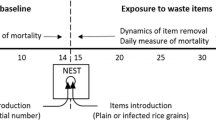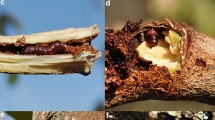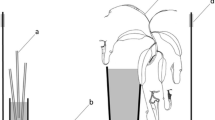Abstract
Nest architecture is a fundamental character shaping immune strategies of social insects. The arboreal ant Temnothorax unifasciatus nests in cavities such as oak galls where the entire colony lives in a unique small chamber. In these conditions, physiological and behavioural strategies likely prevail over compartmentalisation and are presumably tuned with colony size. We designed two experiments to study chemical and behavioural immune strategies against the entomopathogenic fungus Metarhizium anisopliae in colonies of different sizes. First, we compared spore germination and length of germinal tubes inside artificial nests, designed to impede the contact between the ants and the fungus, in colonies of different size. In the absence of direct contact, Temnothorax unifasciatus colonies inhibit fungal growth inside their nests, presumably through volatile compounds. The analysis revealed a positive correlation between fungistatic activity and colony size, indicating that workers of smaller colonies do not invest a higher per capita effort in producing such substances compared to larger colonies. Second, we performed a removal experiment of contaminated and non-contaminated items introduced inside the nests of colonies of different size. Small colonies challenged with contaminated fibres showed an increased removal of all the items (both contaminated and non-contaminated) compared to small colonies challenged with non-contaminated fibres only. Conversely, larger colonies moved items regardless of the presence of the spores inside the nest. Colony size qualitatively affected removal of waste items showing a pathogen elicited reaction in small colonies to optimise the reduced workforce, while the removal behaviour in larger colonies revealed to be expressed constitutively.



Similar content being viewed by others
References
Anderson C, Ratnieks FL (1999) Task partitioning in foraging: general principles, efficiency and information reliability of queueing delays. In: Detrain C, Deneubourg JL, Pasteels JM, Pasteels JM (eds) Information processing in social insects. Birkhäuser, Basel, pp 31–50
Baracchi D, Cini A (2014) A socio-spatial combined approach confirms a highly compartmentalised structure in honeybees. Ethology 120:1167–1176
Bordoni A, Dapporto L, Tatini I, Celli M, Bercigli M, Ressurrección Barrufet S, Perito B, Turillazzi S (2018) Trans-generational immunization in the acrobat ant Crematogaster scutellaris. Biol Lett 14:20170761
Bourke AF, Franks NR, Franks NR (1995) Social evolution in ants. Princeton University Press, Princeton
Brühl C (2003) Vollenhovia sp. aff. acanthina: an ant species that build nests using resin. ANeT Newslett 6:21–22
Chapuisat M, Oppliger A, Magliano P, Christe P (2007) Wood ants use resin to protect themselves against pathogens. Proc R Soc Lond B 274:2013–2017
Chen J, Henderson G, Grimm CC et al (1998) Termites fumigate their nests with naphthalene. Nature 392:558
Christe P, Oppliger A, Bancalà F et al (2003) Evidence for collective medication in ants. Ecol Lett 6:19–22
Colin T, Doums C, Péronnet R, Molet M (2017) Decreasing worker size diversity does not affect colony performance during laboratory challenges in the ant Temnothorax nylanderi. Behav Ecol Sociobiol 71:92
Cremer S, Armitage SA, Schmid-Hempel P (2007). Social immunity. Current biology, 17(16), R693-R702.
Czechowski W, Radchenko A, Czechowska W (2002) The ants (Hymenoptera, Formicidae) of Poland. Museum and Institute of Zoology Warszawa, Warszawa
Diez L, Deneubourg J-L, Detrain C (2012) Social prophylaxis through distant corpse removal in ants. Naturwissenschaften 99:833–842
Dornhaus A, Franks NR (2006) Colony size affects collective decision-making in the ant Temnothorax albipennis. Insect Soc 53:420–427
Dornhaus A, Holley JA, Pook VG., Worswick G, Franks NR (2008). Why do not all workers work? Colony size and workload during emigrations in the ant Temnothorax albipennis. Behavioral Ecology and Sociobiology, 63(1), 43–51
Espadaler X, Nieves-Aldrey JL (1983) Hormigas (Hymenoptera, formicidae) pobladoras de agallas abandonadas de cinipidos (Hymenoptera, cynipidae) sobre Quercus SP en la Peninsula Iberica. Bol Estacion Cent Ecol 12:89–93
Gautrais J, Theraulaz G, Deneubourg J-L, Anderson C (2002) Emergent polyethism as a consequence of increased colony size in insect societies. J Theor Biol 215:363–373
Ghisalberti EL (1979) Propolis: a review. Bee World 60:59–84
Heinze J, Walter B (2010) Moribund ants leave their nests to die in social isolation. Curr Biol 20:249–252
Herbers JM (1981) Reliability theory and foraging by ants. J Theor Biol 89:175–189
Hoggard SJ, Wilson PD, Beattie AJ, Stow AJ (2011) Social complexity and nesting habits are factors in the evolution of antimicrobial defences in wasps. PLoS One 6:e21763
Hölldobler B, Wilson EO (1990) The ants. Harvard University Press, Cambridge
Jeanne RL, Bouwma AM (2002) Scaling in nests of a social wasp: a property of the social group. Biol Bull 202:289–295
Karlik J, Epps MJ, Dunn RR, Penick CA (2016) Life Inside an Acorn: How Microclimate and Microbes Influence Nest Organization in Temnothorax Ants. Ethology 122:790–797
Leclerc J-B, Detrain C (2018) Impact of colony size on survival and sanitary strategies in fungus-infected ant colonies. Behav Ecol Sociobiol 72:3
London KB, Jeanne RL (2003) Effects of colony size and stage of development on defense response by the swarm-founding wasp Polybia occidentalis. Behav Ecol Sociobiol 54:539–546
Luque GM, Giraud T, Courchamp F (2013) Allee effects in ants. J Anim Ecol 82:956–965
Mackay WP (2000) A review of the New World ants of the subgenus Myrafant, (genus Leptothorax)(Hymenoptera: Formicidae). Sociobiology 36
Menzel R (1979) Spectral Sensitivity and Color Vision in Invertebrates. In: Autrum H (ed) Handbook of Sensory Physiology, Springer, Berlin, 503–566
Penick CA, Halawani O, Pearson B et al (2018) External immunity in ant societies: sociality and colony size do not predict investment in antimicrobials. R Soc Open Sci 5:171332
Perito B, Cremonini M, Montecchi T, Turillazzi S (2018) A preliminary study on the antimicrobial activity of sting secretion and gastral glands of the acrobat ant Crematogaster scutellaris. Bull Insectol 71:97–101
Rosengaus RB, Guldin MR, Traniello JF (1998) Inhibitory effect of termite fecal pellets on fungal spore germination. J Chem Ecol 24:1697–1706
Schluns H, Crozier RH (2009) Molecular and chemical immune defenses in ants (Hymenoptera: Formicidae). Myrmecol News 12:237–249
Schmid-Hempel P (1998) Parasites in social insects. Princeton University Press, Princeton
Simone M, Evans JD, Spivak M (2009) Resin collection and social immunity in honey bees. Evol Int J Org Evol 63:3016–3022
Storey GK, Vander Meer RK, Boucias DG, McCoy CW (1991) Effect of fire ant (Solenopsis invicta) venom alkaloids on the in vitro germination and development of selected entomogenous fungi. J Invertebr Pathol 58:88–95
Stow A, Briscoe D, Gillings M, Holley M, Smith S, Leys R, Silberbauer T, Turnbull C, Beattie A (2007) Antimicrobial defences increase with sociality in bees. Biol Lett 3:422–424
Stroeymeyt N, Casillas-Pérez B, Cremer S (2014) Organisational immunity in social insects. Curr Opin Insect Sci 5:1–15
Tranter C, Hughes WH (2016) A preliminary study of nest structure and composition of the weaver ant Polyrhachis (Cyrtomyrma) delecta (Hymenoptera: Formicidae). J Nat Hist 50:1197–1207
Velikova M, Bankova V, Tsvetkova I, Kujumgiev A, Marcucci MC (2000) Antibacterial ent-kaurene from Brazilian propolis of native stingless bees. Fitoterapia 71:693–696
Wang L, Elliott B, Jin X et al (2015) Antimicrobial properties of nest volatiles in red imported fire ants, Solenopsis invicta (hymenoptera: formicidae). Sci Nat 102:66
Yek SH, Mueller UG (2011) The metapleural gland of ants. Biol Rev 86:774–791
Author information
Authors and Affiliations
Corresponding author
Ethics declarations
Conflict of interest
The authors declare that they have no conflict of interest.
Ethical approval
Temnothorax unifasciatus was used for this study. All applicable international, national and/or institutional guidelines for the care and use of animals were followed. This article does not contain any study with human participants.
Additional information
Communicated by: Paula Roig Boixeda
Publisher’s note
Springer Nature remains neutral with regard to jurisdictional claims in published maps and institutional affiliations.
Rights and permissions
About this article
Cite this article
Bordoni, A., Matejkova, Z., Chimenti, L. et al. Home economics in an oak gall: behavioural and chemical immune strategies against a fungal pathogen in Temnothorax ant nests. Sci Nat 106, 61 (2019). https://doi.org/10.1007/s00114-019-1659-0
Received:
Revised:
Accepted:
Published:
DOI: https://doi.org/10.1007/s00114-019-1659-0




